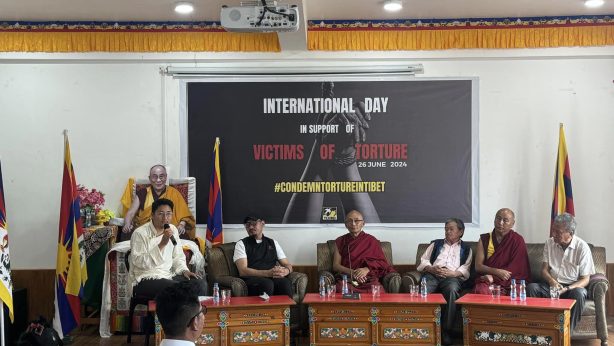Guest Post: Remembering a noble soul on his second death anniversary
By Jayang Jinpa*
The noble soul Sangye Gyatso was born in 1969 in a nomadic village called Lha De Sangkhog in Amdo, Eastern Tibet. His father’s name was Gobha and mother’s Soelo. At the age of 16, he became monk and joined Thoesamling dratsang (college), at the famous Labrang Tashikyil Monastery. He was regarded as one of the brightest students in his class when it came to learning Buddhist texts. In 1991, when he was 23, he left for India to do further studies. He joined Gomang dratsang at Drepung Monastery, South India. The weather of the sub-continent was not suitable to his health. After studying for nearly three years at Drepung, he returned to his homeland. His passion for Buddhist studies did not die down however; once again he joined the Labrang Tashikyil Monastery.

Sangye Gyatso was a diligent student, attending the prayers of the monastery regularly and learning the Buddhist texts seriously. Although we were in different classes, we came from the same dratsang and had become close Dharma-friends, attending the Dharma teachings together for three years. Sangye Gyatso was kind and attentive to the new students. He spent much time with them, especially with those who were keen to learn more. Even when official debating session got over at 9 pm, he would sit with them, encourage and guide them to have further debates on Buddhist philosophy.
I can still visualize him having debates with the new monks. He never suffered from pomposity. He spoke clearly, but with a low voice. He was a very unassuming person. His mind was focused fully on the subject of his debate and never digressed from it. Because of such humility, the younger monks felt no hesitation in responding to his questions and arguments. It would be no exaggeration to claim that people like Sangye Gyatso were like keys that opened the secret doors of Buddhist logic to the minds of young monks. While attending the summer prayer sessions, he wore a simple monastic robe, which was neither new nor old and worn out, but modest. It was as if his monastic robe reflected the Buddhist ideal of moderation – that is avoiding the two extremities of luxury and poverty.
On 14 and 15 March 2008, when protests for Tibetan freedom erupted in Labrang also, the noble soul was among the first to join and lead them. Unconvinced by the sweet-lies propagated by the Chinese government propaganda, many truth-and-freedom loving foreign journalists visited Tibet to find out the real facts on the ground. Although every journalist wanted to visit the Tibetan areas, only a few could escape the traps set up by the Chinese economic might. These included journalists, led by the BBC crew, who visited Labrang on 9 April 2008. On that day, there were around 30 brave monks who protested in front of them. Sangye Gyatso was one of them. I personally witnessed how he risked his life and exposed the brutal nature of the Chinese occupation by raising the following slogans:
Tibetans have no rights and freedom under the Chinese regime
Chinese police fired tear gas on protestors
Chinese soldiers still remain in and around our monastery
Many protesters have been arrested
Tibetans are forced to condemn His Holiness the Dalai Lama.
The Dalai Lama must immediately be allowed to return to Tibet.
He said accusations of Tibetans carrying knives were ‘lies invented by the Chinese government’ in order to delegitimise the peaceful uprising. This protest was an act of seeking truth by risking one’s life and an axe of sharp words struck on the chest of a lie-infested government. Amidst chaos of protest on that day, Sangye Gyatso suddenly disappeared from my eyes. Since that day, I have never seen him.
After the protests, he escaped into the mountains, where because of bad weather he faced many difficulties. As the Chinese were looking for his arrests, it was beyond his dream to get himself cured in a decent hospital when he got sick. His friends and relatives procured medicines for him from minor hospitals, but his health conditions deteriorated beyond recovery. His face and body became emaciated. He was taken to a hospital in Siling (Ch: Xining) but the doctors failed to cure him. Finally he had to undergo surgery. We heard all these information from our sources, but they only contributed to the heaps of suffering already inflicted us. While in the hospital, the Chinese acted as if nothing was wrong and let the patient be himself. The Chinese did this because they knew the patient would not survive and his death in the hospital would somehow ‘absolve’ them from their crimes. The doctors who performed his surgery said that he should have been brought to the hospital much earlier so that he could be treated duly and that chances of his survival were now almost nil.
Not long after, we received the sad news of his death. The noble soul passed away on 26 February 2011. The tragedy did not end there. Weeks later, out of grief and sorrow for the loss of her son, Sangye Gyatso’s mother passed away. She could not even complete the customary forty-nine days of Buddhist prayers and rituals for her dead son!
*Jayang Jinpa and Sangye Gyatso were among the 15 Tibetan monks who staged a daring protest on 9 April 2008 in front of a group of international and Chinese journalists at Labrang Tashikyil Monastery in Sangchu County. The protest lasted for about 10 minutes but was quickly suppressed. Jinpa, 26, now lives in India.
Note: This article appeared in the print publication of TCHRD’s biweekly newsletter (16-31 February 2013)


